 Introduction to Animation
Introduction to Animation
![]() A
WALK ON THE ANIMATION SIDE:
A
WALK ON THE ANIMATION SIDE:
Animating a walk can be a challenge for any animator. They become much easier when we keep in mind a few important elements, such as: EMOTION, WEIGHT, and strong KEY POSES. Of course these ingredients are important to any form of animation - 2D or 3D.
The element we begin with is EMOTION, Ask yourself... WHO IS YOUR CHARACTER?...WHAT IS HE, SHE OR IT'S EMOTIONAL STATE OF MIND?... WHERE ARE THEY GOING?...WHERE ARE THEY COMING FROM?...AND WHY?
EMOTION affects EVERY aspect of the walk.
The GREATER the emotional weight...the GREATER the physical weight.
An ANGRY walk should be forceful and have more weight.. A SAD or DEPRESSED walk will display more weight but be more sluggish and seem closer to the ground. During a HAPPY or JOYOUS walk the character will seem lighter and his movements freer and further from the ground. Knowing the EMOTION of the character is the first step of any walk.
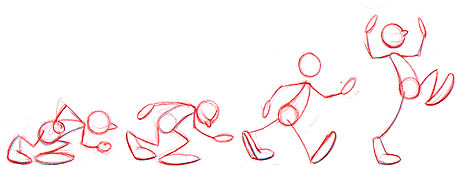
Some examples of EMOTIONS. (Note the WEIGHT differences)
WEIGHT is the next ingredient of a walk! Again, THE GREATER THE EMOTIONAL WEIGHT...THE GREATER PHYSICAL WEIGHT

WEIGHT can be shown in the FEET...LEGS and BODY. Specifically, SQUASHING the FEET, the QUADRICEPS and the BELLY can add greater weight to the character. Having the "weight of the world" on his shoulders can be shown physically.
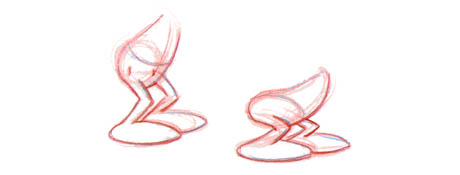
Once the ideas of EMOTION and WEIGHT are thought out we add STRONG POSING... which means THUMBNAILS!

To better understand the movement...let's begin with the PRIMARY ACTION of the HIPS , LEGS and FEET.
| The first pose is the CONTACT position. Feel
free to indicate the hips and to designate the left foot and the right
foot. Note: The HEEL of the LEFT foot and the TOE of the RIGHT foot make contact. The CONTACT postion measures of the stride. The left and right feet are in different places on the plane. |
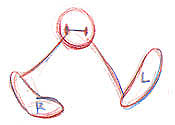 |
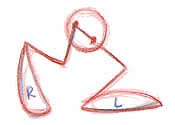 |
The next KEY POSE is the RECOIL pose.
It works best as the very next drawing of the walk. It is usually the LOWEST pose in the movement. RECOIL pose shows a lot of WEIGHT and IMPACT....especially when it follows the CONTACT pose. |
| Note: During as normal walk, Go from the CONTACT to the RECOIL in one drawing - no inbetweens or it will look mushy Notice the SQUASH (WEIGHT) of the foot... | 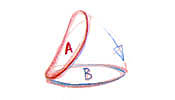 |
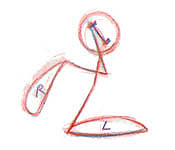 |
The next pose of the walk is the PASSING POSITION; where one leg passes the other as it advances forward. The PASSING POSITION or POSE can be the highest point of the walk. NOTE: The right hip has rotated upward in an arc. |
IT IS VERY IMPORTANT TO MAKE THE KNEE OF THE PASSING LEG "READ"!!!
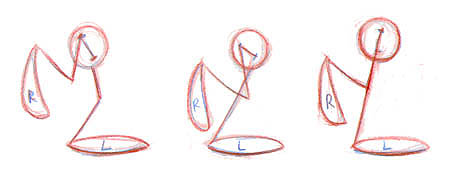
| ALWAYS
draw a good "READABLE" SILHOUETTE
Generally, the PASSING POSE shows the MOST WEIGHT of all the drawings in a walk. Remember, the leg moving forward has separate ARCS for the HIPS, KNEES, ANKLES and TOES. |
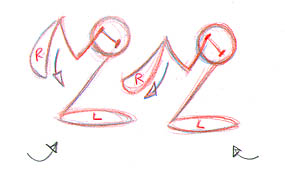 |
 |
As the leg come forward...you can bring the FOOT forward in one of these two ways. |
The next KEY POSE of the walk is just the reverse of the first CONTACT POSE.
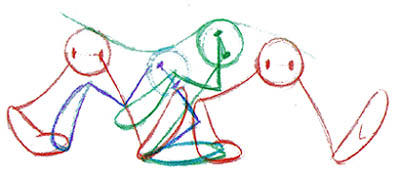
Once the PRIMARY action is KEYED OUT; pencil test the KEYS and check out the movements and timing. Try these timings:
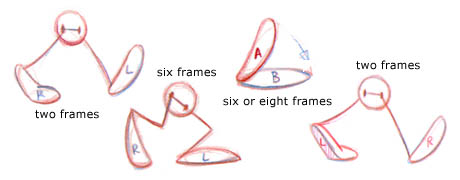
NOTE: The six frames and eight frames indicate the key pose plus two or three inbetween drawings.
| ANOTHER NOTE:
Between the CONTACT position and the PASSING postion the character
will be ON BALANCE. Between the PASSING position and
the next CONTACT drawing the character will be OFF BALANCE.
If the character is walking across the fram, the CONTACT measure the length of the STRIDE - the placement of the toes and heels are important. |
 |

| Once the PRIMARY
action is tested - we can add the torso, a SECONDARY action.
Avoid having the torso be too "straight up". The character will become stiff. Lean the torso slightly forward. |
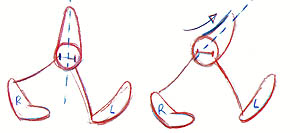 |
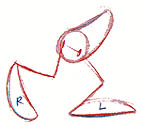 |
During the RECOIL position, bring the torso forward. |
| During the PASSING
position, you have two options for the torso and spine. REVERSING
the spine (a BODY REVERSAL) when the leg extends makes for
a more fluid movement. (NOTE: We will cover BODY REVERSALS more in another lesson.) |
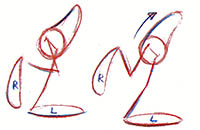 |
Next, we add the character's head, another SECONDARY action...
NOTE: You can use OPPOSITE actions to create greater flexibility of the head and neck.

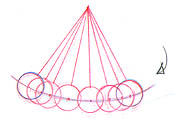 |
The last phase of
the walk is the SECONDARY action of the arm swing. The arm swing is like a pendulum. The movement is motivated by the SHOULDER....NOT the hand! |
| The shoulders move opposite the hips. When the left arm is forward the left leg is back. When the right arm is back the right leg is forward. | 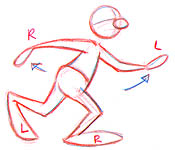 |
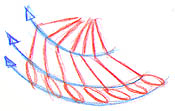 |
NOTE:
a Nice OVERLAPPING ACTION can occur by having the arm swing
be at it's extreme positon during the "RECOIL" position and
not the CONTACT position. Generally, the arm slows in and out at either end of each swing. Don't forget too add the inbetweens and then pencil test. |
Review
TO RECAP
- Remember, the most important ingredients of a walk are EMOTION, WEIGHT and STRONG KEY POSES.
- Draw out the PRIMARY ACTION of the hips, legs and feet
- Show WEIGHT in the feet.
- Draw your CONTACT pose, then your RECOIL pose, then your PASSING pose, and then the opposite side CONTACT pose.
- Be aware of OPPOSITE ACTIONS in the torso, head and arm swing.
- EVERY part of the body has it's own ARC.